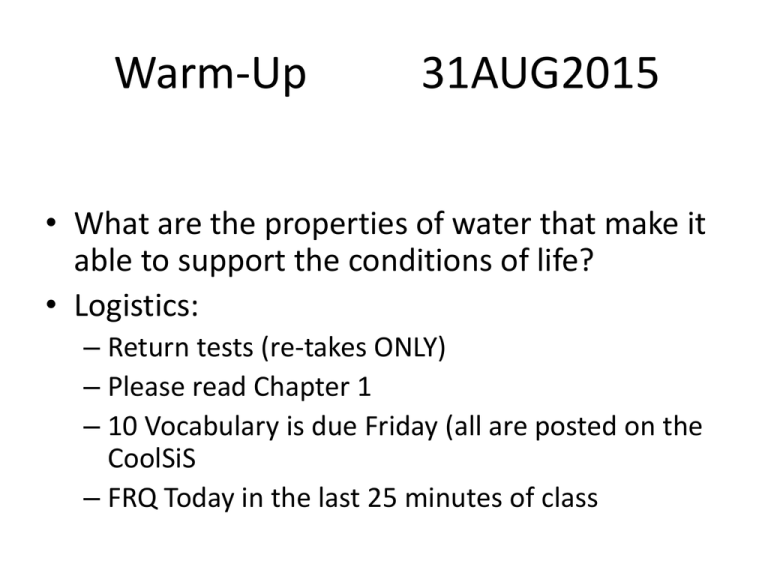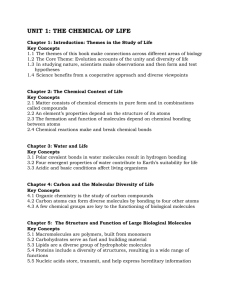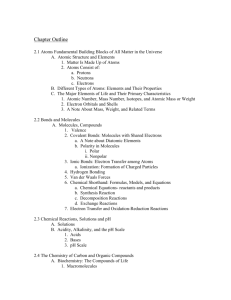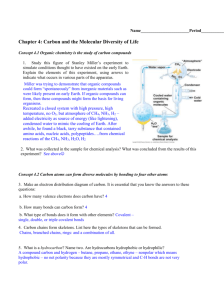File
advertisement

Warm-Up 31AUG2015 • What are the properties of water that make it able to support the conditions of life? • Logistics: – Return tests (re-takes ONLY) – Please read Chapter 1 – 10 Vocabulary is due Friday (all are posted on the CoolSiS – FRQ Today in the last 25 minutes of class Earth is a single interconnected system AKA: EVERYTHING IS CONNECTED All environmental systems consist of matter • Matter- anything that occupies space and has mass. • Mass- a measure of the amount of matter an object contains. • Weight- the force that results from the action of gravity on mass. Warm-Up 01SEP2015 • Compare and contrast mass and weight. • Matter- anything that occupies space and has mass. • Mass- a measure of the amount of matter an object contains. • Weight- the force that results from the action of gravity on mass. • Abiotic + biotic = Ecosystem! Atoms and Molecules • Atom- the smallest particle that can contain the chemical properties of an element. • Element- a substance composed of atoms that cannot be broken down into smaller, simpler components. Elements can be solid, liquid or gas. • Periodic Table- lists all the elements currently known. • Molecules- particles containing more than one atom. • Compounds- molecules that contain more than one element. Atoms and Molecules • Atomic Number- the number of protons in the nucleus of a particular element. • Mass Number- the total number of protons and neutrons in an element. • Isotopes- atoms of the same element that have different numbers of neutrons, and therefore different atomic masses. Radioactivity • Radioactive decay- the spontaneous release of material from the nucleus of an unstable isotope. • Radioactive decay changes the radioactive element into a different element. i.e. Uranium-235 decays to form Thorium-231. • Uranium is called the parent and thorium the daughter. Radioactivity • Half-life- the time it takes for one-half of the original radioactive parent atoms to decay. • Some elements that undergo radioactive decay emit harmful radiation. • Knowledge of the half-life allows scientists to determine the length of time that a radioactive element may be dangerous. Chemical bonds • Covalent bonds- elements that form compounds by sharing electrons. (methane) Chemical bonds • Ionic bonds- elements that form compounds by transferring electrons from one element to another. • When this transfer happens, one atom becomes electron deficient (positively charged) and one atom becomes electron rich (negatively charged) Chemical bonds Chemical bonds • Hydrogen bonds- a weak chemical bond that forms when hydrogen atoms that are covalently bonded to one atom are attracted to another atom on another molecule. • Water is known as a polar molecule, one side is more positive and the other side is more negative. Chemical bonds acids, bases, and pH • Acid- a substance that contributes hydrogen ions to a solution. • Base- a substance that contributes hydroxide ions to a solution. acids, bases, and pH • pH- a way to indicate the strength of acids and bases. • The pH scales ranges from 0 - 14. • A pH value of 7 is neutral • A pH above 7 is basic • A pH below 7 is acidic pH Mini-Lab • Measure the pH of all the items. • Record your data on a separate sheet of paper. • Bring one of your acidic solutions to a neutral pH. – Provide directions on how you did this – Turn this in! Warm-Up 02SEP2015 • Name and describe the 3 types of chemical bonds. – Logistics: Please be reading chapter 2 • Tomorrow we will complete a “popcorn relay” be ready to go outside • 10 Vocabulary words are due Friday Properties of water • Surface tension- the result from the cohesion of water molecules at the surface of a body of water. • Capillary action- when adhesion of water molecules to a surface is stronger than cohesion between the molecules. Properties of water • Boiling and freezing- at Earth’s surface, water boils at 100 degrees celsius and freezes at 0 degrees celsius. • Water as a solvent- many substances dissolve well in water because their polar molecules bond easily with other polar molecules. (UNIVERSAL SOLVENT) Properties of water acids, bases, and pH Chemical reactions and the conservation of matter • Chemical reaction- occurs when atoms separate from the molecules they are a part of or recombine with other molecules. • Law of conservation of matter- matter cannot be created or destroyed; it can only change form. Biological molecules and cells • Inorganic compounds- compounds that do not contain carbon or do contain carbon, but only carbon bound to elements other than hydrogen. • ex. NH3, NaCL, H2O, and CO2 • Organic compounds- compounds that have carbon-carbon and carbonhydrogen bonds. Biological molecules and cells • Carbohydrates- compounds composed of carbon, hydrogen,and oxygen atoms. Ex. C6H12O6 • Proteins- made up of long chains of nitrogencontaining organic molecules called amino acids. • • Nucleic Acids- organic compounds found in all living cells. • DNA • RNA Lipids- smaller biological molecules that do not mix with water. Ex. fats, waxes and steroids. Biological molecules and cells • Cells- the smallest structural and functional component of organisms. • single cells- Ex. bacteria and some algae • multicellular- Ex. bring shrimp • What are the 3 types of chemical bonds? • What are the unique properties of water? In what ways do those properties make life possible on Earth? • What are the 4 types of biological molecules?







